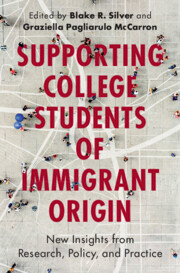Book contents
- Supporting College Students of Immigrant Origin
- Supporting College Students of Immigrant Origin
- Copyright page
- Dedication
- Contents
- Figures
- Tables
- Contributors
- Foreword
- Part I Beginnings
- Part II Experiences
- Part III Institutional Arrangements
- Chapter 12 Student Success Considerations for First-generation, Working-class Latinx College Students
- Chapter 13 Honoring Immigrant College Students’ Funds of Knowledge through Appreciative Advising
- Chapter 14 How Institutional Policies and Practices Impact Black Immigrant College Students’ Experiences
- Chapter 15 Understanding the Personal Support Networks of First-generation College Students from Immigrant Backgrounds
- Chapter 16 Institutional Responsibility for International Student Well-being and Belongingness
- Part IV Looking Forward
- Epilogue
- Index
- References
Chapter 14 - How Institutional Policies and Practices Impact Black Immigrant College Students’ Experiences
from Part III - Institutional Arrangements
Published online by Cambridge University Press: 16 May 2024
- Supporting College Students of Immigrant Origin
- Supporting College Students of Immigrant Origin
- Copyright page
- Dedication
- Contents
- Figures
- Tables
- Contributors
- Foreword
- Part I Beginnings
- Part II Experiences
- Part III Institutional Arrangements
- Chapter 12 Student Success Considerations for First-generation, Working-class Latinx College Students
- Chapter 13 Honoring Immigrant College Students’ Funds of Knowledge through Appreciative Advising
- Chapter 14 How Institutional Policies and Practices Impact Black Immigrant College Students’ Experiences
- Chapter 15 Understanding the Personal Support Networks of First-generation College Students from Immigrant Backgrounds
- Chapter 16 Institutional Responsibility for International Student Well-being and Belongingness
- Part IV Looking Forward
- Epilogue
- Index
- References
Summary
Since the Immigration and Nationality Act of 1965, Black immigrants have migrated to the United States in increasing numbers (Tamir & Anderson, 2022) and have helped transform the Black population (Kent, 2007) in the United States broadly and within higher education (George Mwangi, 2014). Despite their racialization, experiences, and collective interests among Black students, Black immigrant collegians’ histories are distinct from Black students who are descendants of enslaved Africans. Even though they have specific educational and cultural supports to address their needs, Black immigrant collegian experiences are often understudied or excluded from immigrant scholarship (George Mwangi, 2014; Hutchinson, 2018). Further ignored are the impacts of colonialism and marginalization in US culture that shape Black immigrant student experiences (Kasinitz, 2008). This chapter analyzes institutional forces that impact Black immigrant experiences on US campuses, with particular attention to broader histories of colonialism and marginalization. We utilize an emergent framework, Culturally Engaging Campus Environments (Museus & Smith, 2016), to explore how Black immigrants navigate higher education.
- Type
- Chapter
- Information
- Supporting College Students of Immigrant OriginNew Insights from Research, Policy, and Practice, pp. 290 - 309Publisher: Cambridge University PressPrint publication year: 2024

